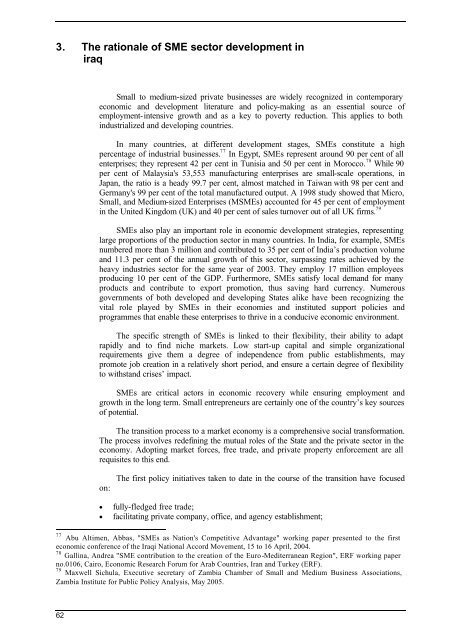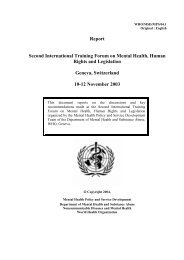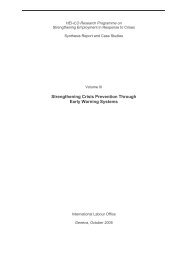Volume 1 Cedric - revised luca Final - RUIG-GIAN
Volume 1 Cedric - revised luca Final - RUIG-GIAN
Volume 1 Cedric - revised luca Final - RUIG-GIAN
You also want an ePaper? Increase the reach of your titles
YUMPU automatically turns print PDFs into web optimized ePapers that Google loves.
3. The rationale of SME sector development iniraqSmall to medium-sized private businesses are widely recognized in contemporaryeconomic and development literature and policy-making as an essential source ofemployment-intensive growth and as a key to poverty reduction. This applies to bothindustrialized and developing countries.In many countries, at different development stages, SMEs constitute a highpercentage of industrial businesses. 77 In Egypt, SMEs represent around 90 per cent of allenterprises; they represent 42 per cent in Tunisia and 50 per cent in Morocco. 78 While 90per cent of Malaysia's 53,553 manufacturing enterprises are small-scale operations, inJapan, the ratio is a heady 99.7 per cent, almost matched in Taiwan with 98 per cent andGermany's 99 per cent of the total manufactured output. A 1998 study showed that Micro,Small, and Medium-sized Enterprises (MSMEs) accounted for 45 per cent of employmentin the United Kingdom (UK) and 40 per cent of sales turnover out of all UK firms. 79SMEs also play an important role in economic development strategies, representinglarge proportions of the production sector in many countries. In India, for example, SMEsnumbered more than 3 million and contributed to 35 per cent of India’s production volumeand 11.3 per cent of the annual growth of this sector, surpassing rates achieved by theheavy industries sector for the same year of 2003. They employ 17 million employeesproducing 10 per cent of the GDP. Furthermore, SMEs satisfy local demand for manyproducts and contribute to export promotion, thus saving hard currency. Numerousgovernments of both developed and developing States alike have been recognizing thevital role played by SMEs in their economies and instituted support policies andprogrammes that enable these enterprises to thrive in a conducive economic environment.The specific strength of SMEs is linked to their flexibility, their ability to adaptrapidly and to find niche markets. Low start-up capital and simple organizationalrequirements give them a degree of independence from public establishments, maypromote job creation in a relatively short period, and ensure a certain degree of flexibilityto withstand crises’ impact.SMEs are critical actors in economic recovery while ensuring employment andgrowth in the long term. Small entrepreneurs are certainly one of the country’s key sourcesof potential.The transition process to a market economy is a comprehensive social transformation.The process involves redefining the mutual roles of the State and the private sector in theeconomy. Adopting market forces, free trade, and private property enforcement are allrequisites to this end.on:The first policy initiatives taken to date in the course of the transition have focused• fully-fledged free trade;• facilitating private company, office, and agency establishment;77 Abu Altimen, Abbas, "SMEs as Nation's Competitive Advantage" working paper presented to the firsteconomic conference of the Iraqi National Accord Movement, 15 to 16 April, 2004.78 Gallina, Andrea "SME contribution to the creation of the Euro-Mediterranean Region", ERF working paperno.0106, Cairo, Economic Research Forum for Arab Countries, Iran and Turkey (ERF).79 Maxwell Sichula, Executive secretary of Zambia Chamber of Small and Medium Business Associations,Zambia Institute for Public Policy Analysis, May 2005.62














